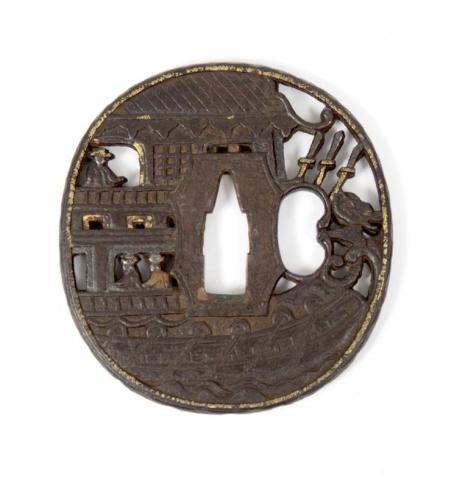Tsuba Namban
Ferro fundido e ouro
Japão, Séc. XVII
Dim.: 7,3 × 6,9 cm
Namban Tsuba
Wrought iron and gold
Japan, 17th century
Dim.: 7,3 x 6,9 cm
Prov.: R. Quintela, Lisbon
Expo.: ‘Venans de Loingtaines Voyages’ Bordeaux, 2019 p. 56
Pub.: ‘Depois dos Barbaros II’, 2008, p. 140
17th century wrought iron (tetsu) Namban tsuba, with remnants of the original gold alloy coating. Decorated on both faces in pierced, cut and engraved low-relief motifs that fill the elongated disk (naga maru-gata) surface, it portrays a magnificent ship, the “Black Ship” (kurofune) of the Portuguese Indian Trade, in this instance represented with clear oriental features on the stern canopy.
Cutting through the centre of the ship, the raised edge (seppa-dai) central orifice (nakago hitsu), designed to fit the blade handle, features to its right an additional oval recess for the spike (kogai), topped by three parallel daggers. To the left, on the ship´s upper deck, three figures in European costume and wide brimmed hats.
The sea waves and the oblique positioned oars suggest motion. Clearly evidenced on the prow, a Japanese dragon (ryu) figurehead, mythical figure that rules the seas, protects the ship. The Japanese were able to borrow from China the custom of merging the dragon (ryu tatsu) with the Imperial institution and the Buddhism.
Tsuba Namban de ferro forjado (tetsu) do seculo XVII, com vestígios de revestimento em liga de ouro. Ornamentada de ambos os lados em abertos e fechados, recortados e gravados, em baixo-relevo, a decoração circunscreve-se à forma circular alongada (naga maru-gata) subdividida em linhas paralelas horizontais, onde se representa magnifica embarcação europeia (barco negro do trato de Macau, designado por Kurofune), miscigenada com cobertura e cimalha oriental.
Esta nau agrupa o orifício central (nakago hitsu) elevado (seppa-dai) e a reentrância necessária ao espeto (kogai), encimada por três punhais (Kogatana) espetados e paralelos. Na plataforma elevada da embarcação o artista assinalou a origem deste barco pela representação de tripulantes vestidos a europeia, com chapéu de aba larga.
As ondas do mar e o casco, com as réguas dos remos colocadas em oblíqua, denunciam que a nau está em movimento. Na proa, em destaque, surge um dragão japonês (ryu) que protege o navio - divindade mítica que, entre as várias lendas, tutela principalmente o mar, simbolizando todo o poder do oceano como rei dos mares. O Japão retirou da China o hábito de conciliar o dragão (Ryu tatsu) com a instituição imperial e o Budismo.
- Arte Colonial e Oriental
- Artes Decorativas
- Diversos

